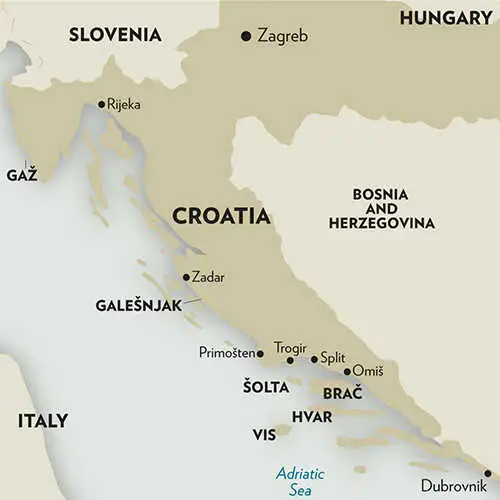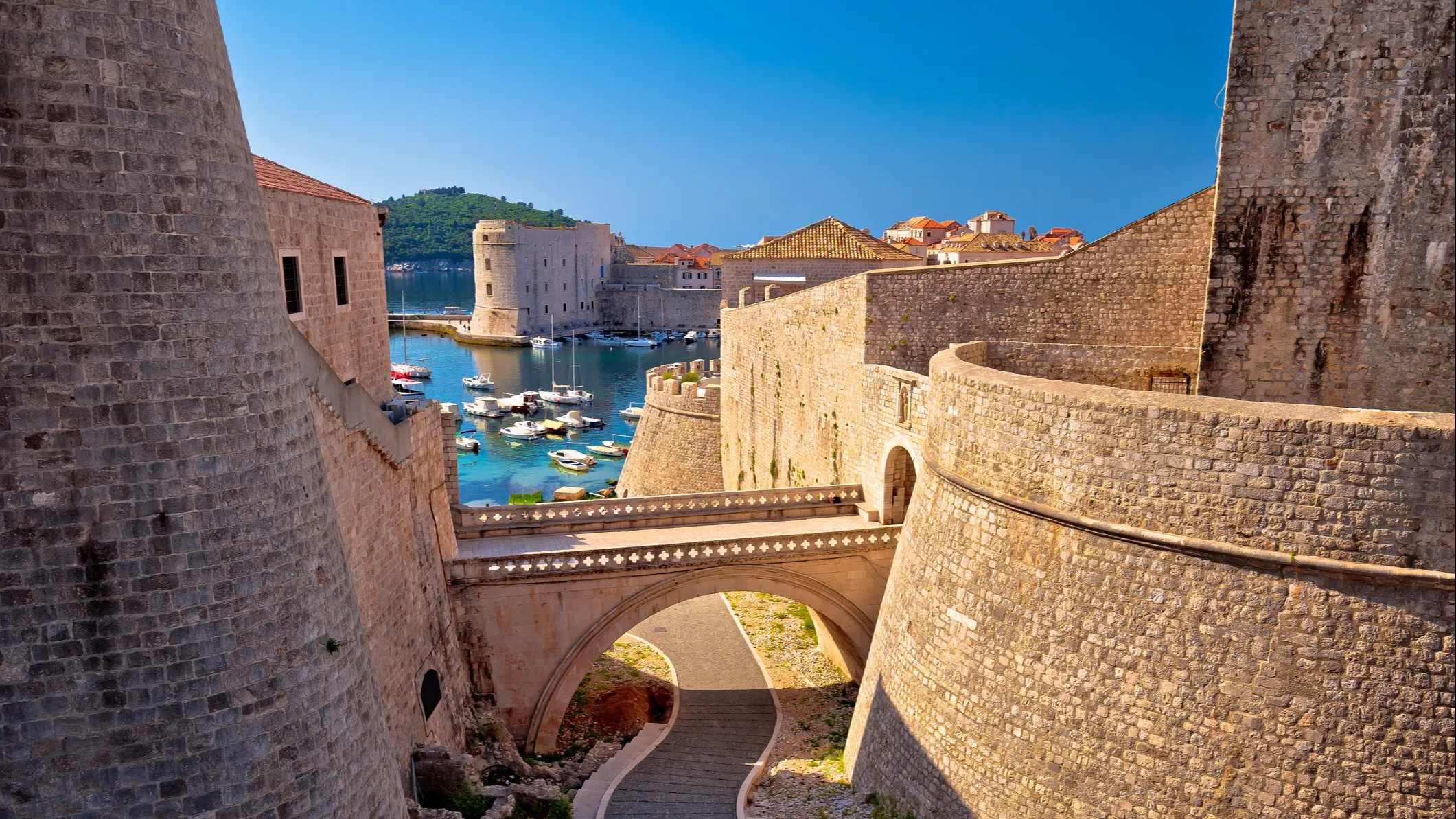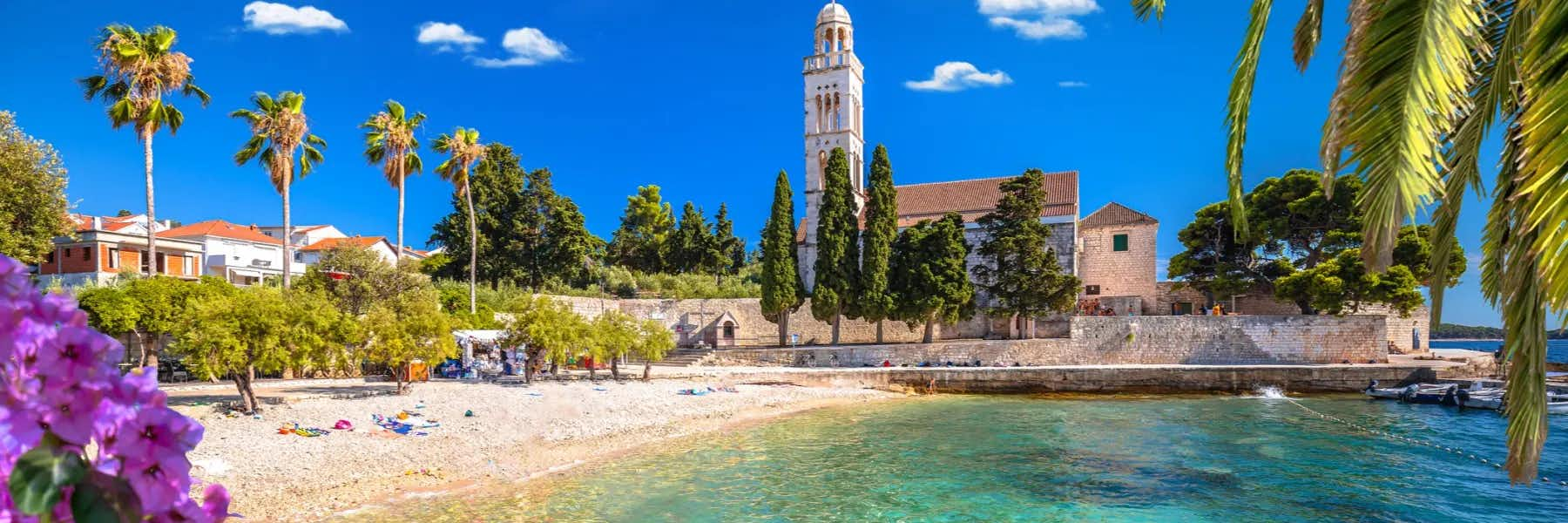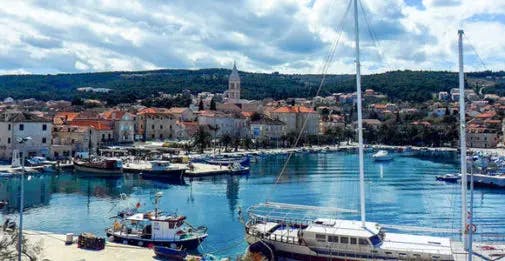By Tricia A. Mitchell
Standing on a cliff, we spotted fishermen pulling in their evening catch before sunset. The sky was fiery-red and deep tangerine, and a fresh breeze was beginning to sweep down the mountains through the pine forest around us. Sometimes, nature seems almost implausible. The scene could have been airbrushed onto the side of a hippie’s creaking RV. My husband, Shawn, and I were returning home after a beautiful day hiking along the coast of Croatia. As if to deliberately complete the picture, two dolphins sprang from the water.
We paused to take in the sunset a bit longer, while recounting everything we had done that day. On a beach all by ourselves we’d enjoyed a picnic filled with fresh produce and Croatian cheese. We’d happened upon the ruins of a Roman villa. We’d hiked through untouched forest, then wandered through a winter wonderland teeming with twinkling Christmas lights and music. The day reminded me why I love Croatia.
Located in southeastern Europe along the Adriatic Sea, Croatia has long been a favorite destination for travelers from neighboring countries. But it’s only been relatively recently that the country has become a darling for tourists from outside the continent. As Croatia, a European Union member, has gained interest among a wider range of vacationers, it’s also garnered attention from individuals who’d like to experience its wide-ranging charms for longer stays.
Two people who are doing just that are Kathy and Tim Litz. After contemplating a move abroad, the Nevada couple decided to plant roots in the coastal city of Rijeka three years ago. Kathy, a retired teacher, says they “immediately loved” Rijeka’s fresh green market, plentiful bakeries, city bus transport, café culture, and having their own butcher and egg vendor.
“We never need more than our pension for our living expenses,” says Kathy, who adds that Rijeka’s housing, food, cellphone, and various other costs amount to less than what they were paying in Las Vegas.
“There is no place in Las Vegas that I could purchase a completely furnished home for €70,000 ($85,200),” Kathy says of their 485-square-foot apartment, which has sea views. For those looking to rent, Kathy says it’s possible to rent an apartment starting at €500 ($610) per month.
Healthcare is also more affordable in Croatia. “Back in the States, I had some [dental] implant work that needed to be repaired. What had cost me over $20,000 in Las Vegas cost me €8,000 ($9,740) here in Rijeka,” she says. (Note that Croatia uses the kuna as its currency.)We never need more than our pension for living.Like Kathy and Tim, Shawn and I have become enamored with Croatia. In total, we’ve been exploring the country in seasonal bursts for eight years. We stay no more than 90 days at a time, and usually visit during the off-season when lodging costs are lower and there are hardly any tourists.
Interestingly enough, we were initially drawn to Croatia because it is not yet a member of the Schengen Area—a bloc of 26 European countries which limits U.S. and Canadian tourists to stays of no more than 90 days within a 180-day period. Jumping out of the Area for a period, to re-set the clock, is a common strategy with roving retirees in Europe. During our first “Schengen hop,” we unexpectedly fell for Croatia’s beautiful landscapes and welcoming people. We also came to appreciate the country’s history, gastronomy, nature, entertainment options, and sunny, maritime character.
Croatia’s laws make it a challenging place for foreigners to stay permanently. However, it has recently joined the growing list of countries offering a digital nomad visa. Like many similar initiatives worldwide, the visa is valid for one year only, and once it’s run out, you’ll have to wait six months before you can qualify for a new one. It’s worth considering though, and Melissa Paul, interviewed below, is one expat who has chosen that residence option. Or perhaps, like us, you’ll choose to explore Croatia on a part-time basis. Either way, there’s truly something special for everyone.

IF YOU LOVE BEING BY THE SEA
Croatia’s mainland has about 1,100 miles of exquisite coastline, and its water is some of the cleanest in Europe. The country is also home to more than 1,000 islands. While only a fraction of them are inhabited, you could spend a lifetime exploring those that are.
Each island has its own claim to fame. Brac is home to Zlatni Rat, one of Croatia’s most photographed beaches. Glitzy Hvar is the sunniest island—with a brilliant 2,724 hours annually. And the blonde-stone cliffs of Vis served as the backdrop for the sequel to the film Mamma Mia. If you’re flying over the Adriatic Sea, you’ll also appreciate the aerial views of the fish-shaped island of Gaž, or the heart-shaped island of Galešnjak.
Sara Dyson, a Texas native who founded the website ExpatinCroatia.com, has been living in the Croatian city of Split for more than eight years. She says that Brac is her favorite island in the Dalmatia region.
“I have spent so much time there with close friends and family who visit from abroad. It is the perfect day trip from Split,” she says. “Our itinerary is always the same. Ferry to Supetar, drive to Vidova Gora at the summit to see the view of the islands of Hvar and Vis, walk along the Bol promenade to Zlatni Rat, drink wine on the beach in front of Stina winery, and dine at Ranc Restaurant before our ferry back to Split.”
Croatia’s national ferry line, Jadrolinija, connects the mainland with the islands year-round, and private catamarans and boats provide additional connections during the tourist season. The mainland cities of Dubrovnik, Rijeka, Split, and Zadar are some of the major ferry hubs. For a one-way Jadrolinija trip lasting two hours, expect to pay about 40 kuna ($6.50) per person. Note that fares are higher if you’re driving a car.
Back on the mainland, the architecture of coastal communities ranges from historic to modern. Some cities—like Dubrovnik, Trogir, and Primošten—brim with enchanting white-stone buildings that date back centuries. In contrast, contemporary resorts and villas have sprung up in places like the Makarska Riviera in recent decades. While the architecture of these coastal towns varies, the aquamarine sea, rocky coastline, and dense pine forests offer a unifying backdrop.Drink wine on the beach in front of Stina winery.Another common feature in coastal towns is the riva, a seaside promenade. These walkways are often lined with palm trees, colorful bougainvillea, and fragrant rosemary hedges. A pilgrimage to the riva is a daily ritual for many residents, regardless of their age, and often, the family dog is also on parade. The riva is where locals come to stroll, meet fishing boats as they glide in with the day’s catch, and sip a cup of kava (black coffee) while engaging in animated conversation at their favorite café.
Croatia’s beaches and coves are exceptionally beautiful, and 93 beaches have been awarded the European Union’s Blue Flag status for cleanliness and amenities. Swimming spots tend to be pebbled or rocky, but you can find some sandy locations. As you prepare to dive into the translucent water, you’ll want to be on the lookout for spiky sea urchins. While they are a culinary delicacy, urchins can be unpleasant if you happen to encounter one underfoot.
Shawn and I have gone swimming as early as May and as late as October—well outside the peak-tourist season. We’ve done so in a variety of settings: quiet coves off the island of Brac, footsteps away from the enchanting walled city of Korcula, and in a protected bay overlooked by Makarska’s imposing mountains.
IF YOU ARE A GOURMAND
Croatia’s regional cuisines are agreeably distinct, thanks to its varied climate zones, and the diverse peoples who have influenced the country’s culinary traditions over the centuries. In coastal regions, you’ll find very different offerings to what’s traditional in the mountains. That’s half the fun.
Istria: Gourmet Ingredients and Italian Flair
The region of Istria—often likened to Tuscany—prides itself on the high-quality truffles, wine, and olive oil it produces. For six years in a row, Flos Olei, an Italian guide that rates the world’s extra virgin olive oil, has declared Istria to be the best olive oil region in the world.
Melissa Paul, who originally hails from California, via New York City, and Philadelphia, has called Croatia home for more than six years. Today, Melissa lives in the Istrian hilltop town of Labin, in a 500-year-old stone house.
When it comes to olive oil, Ipša, Chiavalon, and Negri are her preferred award-winning labels. “They run $125 to $165 per half-liter. But a whole liter can be had for $75 to $100 from a smaller producer. Usually, the producers find you as you wander into a village, or you can ask at the first house,” she explains.
According to Melissa, Istria’s white truffles are typically in season between September and January, whereas black ones are harvested from January until May. “My favorite dish with truffle shavings is scrambled eggs, called fritaja s tartufima. It’s simple, but you really taste the truffle,” she adds.
Istria’s regional wine varietals are white malvazija and red teran. “Fakin, Arman, and Clai are my favorite labels,” Melissa says, and explains that, depending upon the vintage, malvazija sells for $10 to $45 per bottle and teran sells for $15 to $55. “Both can go up drastically for some of the oldest vintages. But you can also get a ‘local guy’s wine’ for a whole lot less,” she says.
Dalmatia: Wine, Fresh Seafood, and Citrus Galore
Like its coastal neighbor to the north, Dalmatia produces Mediterranean staples such as olive oil and wine. But while Istria is the champion when it comes to olive oil accolades, only Dalmatia can claim to be the genetic homeland of the internationally renowned zinfandel grape (Crljenak Kaštelanski).
Dalmatia produces a great variety of red and white wines. They range from delightful white Pošip which originates on the island of Korcula, to Plavac Mali, a full-bodied red wine that was the first Croatian grape to be awarded its own appellation.
Dalmatia is also home to the Neretva Delta. This fertile valley has been dubbed “Croatia’s California” because of the copious amount of citrus fruit it produces. Shawn and I love being in Dalmatia during the wintertime, when fresh market stalls overflow with mountains of mandarins, clementines, and oranges from Neretva. You can buy a pound for about 35 cents.
Dalmatian cuisine can be meat-heavy, as with traditional offerings like dry-cured ham (pršut) or braised beef (pašticada). However, there’s also lighter fare to be found such as grilled fish, cuttlefish, or shrimp risotto (rižot), and side dishes like garlic mashed potatoes and Swiss chard (blitva s krumpirom).
Expat Sara Dyson says that one of her favorite places to eat in Dalmatia is on the island of Brac. She explains that the restaurant, Kapetanovo Lozje, is actually owned by a boat captain and that the setting and food are both memorable.
“This family restaurant is located among olive trees and surrounded by grassy fields and vegetable patches. Tables are scattered under the trees around the property and all you can hear are the sounds of nature. Their grilled lamb (raised on the island) and octopus salad are excellent,” she says.
The Interior: Hearty Fare with Continental Flair
As you move away from the coast, the cuisine makes the most of slow-cooked stews, freshwater fish, and pickled ingredients. There’s also plenty of great wine to be had.
In central Croatia, we once spent a summer exploring the towns near the capital city of Zagreb. At outdoor markets, we were thrilled to find different products than what you’d see along the coast. Some of my favorites were bucino ulje (a dark and delectable pumpkin oil), buckwheat flour for making dark bread, and prgica (a spicy cheese sculpted into a cone shape). Locals in this part of Croatia often mix white wine with sparkling water, something they call gemišt. It is especially refreshing on a hot summer’s day.
Farther to the east is the region of Slavonia—dubbed “Croatia’s breadbasket.” Blanketed with golden sunflowers and fields of wheat, it’s also a land of orchards and vineyards. Slavonia is where you’ll find stewed meat and freshwater fish dishes infused with paprika.
You’ll encounter some fantastic wine in Slavonia, too. If you fancy wine tasting, look no further than the Danube River town of Ilok, one of Slavonia’s best-known winemaking spots. Ilok Cellars produces varietals such as riesling, chardonnay, and graševina. Their traminac was served at Queen Elizabeth’s 1953 coronation.
IF YOU ARE A HISTORY ENTHUSIAST
During the last few thousand years, the land that is now Croatia was influenced by many peoples, including the Illyrians, Greeks, Romans, Austro-Hungarians, Ragusans, Ottomans, Venetians, and Slavs. While not much physical evidence remains from the Illyrians, other civilizations left behind ruins, fortresses, medieval churches, and fascinating cities with multiple layers of history.
Ancient Roman Relics
The most significant ancient Roman relics are in coastal Croatia. In the city of Pula alone, there’s a fabulous 1st-century amphitheater, a temple dedicated to Augustus, and an ornate carved triumphal arch. During the summer, Pula hosts several reenactments, ranging from gladiator fights in the amphitheater to a marketplace in Pula’s ancient forum.
South of Pula, you’ll find more spectacular Roman ruins in Zadar, Split, and Solin. Zadar has a well-preserved Roman forum and a nearby museum that houses artifacts unearthed in the region. Split, Croatia’s second-largest city, is home to the 1,700-year-old retirement palace of the emperor Diocletian. The palace ruins are beautiful in their own right, but what makes them special is that they sit proudly right in the vibrant heart of Split’s Old Town.
A few miles away from Split is the ancient city of Salona, which was one of the largest cities in the Roman Empire. Much of this sprawling archaeological park has yet to be excavated, but archaeologists have uncovered an amphitheater, theater, early Christian basilicas, and burial sites with ornate sarcophagi.
Dubrovnik, Formerly the Republic of Ragusa
You may have heard of Dubrovnik, Croatia’s so-called “Pearl of the Adriatic.” This magnificent walled city began life as the Republic of Ragusa, a maritime republic. An interesting details is that Ragusa was one of the first countries to recognize the independence of the United States. Dubrovnik has been a UNESCO World Heritage site since 1979, and has gained recent fame as a filming location for the HBO series Game of Thrones.
Venetian Towns and Fortifications
For several hundred years, coastal Croatia was part of the Republic of Venice. The Venetians, a maritime power, fended off the Ottoman Turks for much of that time. This required them to build fortifications and strengthen existing ones. Two of them are now UNESCO World Heritage sites, including Fort St. Nikola near the town of Šibenik, and the fortified peninsula of Zadar.
The Venetians also left behind a strong architectural legacy in several towns. Two of the prettiest are pastel-colored Rovinj, and tiny Trogir, which is filled with delightful Renaissance and Romanesque architecture.
Austro-Hungarian Swagger
Croatia was part of the Austro-Hungarian Empire from 1867 to 1918. In cities like Zagreb, Varaždin, and Osijek, the empire left behind handsome theaters and intricate baroque architecture reminiscent of what you’d see in Vienna, Budapest, or Prague.
IF YOU CRAVE NATURE
From rugged mountains to some of the prettiest coastline in the world, Croatia is especially rich when it comes to biodiversity—offering visitors the chance to spot an impressive 375 bird species. It’s also home to eight national parks. For waterfalls and emerald-colored lakes, hit up Plitvice and Krka National Parks. Other highlights include the barren-but-beautiful islands of Kornati National Park, and the densely forested island of Mljet.
Though it is not a national park, Biokovo Nature Park is a popular spot for travelers soaking up the sun along the Makarska Riviera. A recent addition to this park is the Skywalk, a glass observation deck stretching out over sheer cliffs with commanding views of the Dalmatian coast.
Cities often incorporate nature into their planning. Some feature riverside walkways or trails on forested peninsulas overlooking the sea. Hiking, cycling, and rock-climbing opportunities exist throughout the country. In Split’s urban forest park of Marjan, you can do all three activities in one day.
IF YOU ENJOY ENTERTAINMENT AND SIGHTSEEING
Croatia is replete with things to see and do. From incredible castles and fortresses to lively festivals and events, the country is certain to amaze.
Castles and Fortifications

Dubrovnik is Croatia’s foremost tourist attraction. Enormous stone walls encircle the city’s elegant stone buildings and churches. One of the best ways to glimpse this architecture is to walk atop the walls. Or, for a superb bird’s eye view of the terracotta-roofed city and its neighboring islands, head to the top of neighboring Mount Srd, via the cable car.
Not far from Dubrovnik is Ston, which, like Dubrovnik, was once part of the Republic of Ragusa. Ston’s ribbonlike defensive walls stretch for nearly four miles. The ruling Republic of Ragusa started building them in the 14th century in order to protect Ston’s sea-salt pans. Still known for its salt seven centuries later, Ston is also the place to go for mussels and oysters.
Another impressive fortification is the formidable Klis Fortress. This stronghold sits atop a rocky ridge and straddles a mountain pass connecting the inland to the coast. It makes a great day trip from Split.
Croatia’s inland is home to many stately castles. In the Zagorje region, you’ll find the 16th-century Veliki Tabor Castle, as well as Trakošcan, which overlooks a tranquil lake. Not far away is Varazdin Castle, which holds court in the elegant baroque city of the same name. Protected by a drawbridge and adorned with rounded towers, the castle is the stuff of fairy tales.
Events and Festivals
Every August in the former pirate stronghold of Omiš, actors on ships reenact a historical battle. With cannons and pistols firing through crimson-red smoke, the event is a feast for the senses. Another special summer event in Omiš is the annual klapa festival. Klapa is a type of traditional a cappella singing that originates along the coast.
In the wintertime, Croatia’s capital city of Zagreb plays host to a sweet Christmas market. The town’s squares are filled with an ice-skating rink and chalet-style huts selling handmade souvenirs, hot mulled wine (kuhano vino), and peppery gingerbread cookies (paprenjaci).
In the hilltop Istrian town of Motovun, the visual arts are flourishing. Every summer, the walled community hosts a multi-day film festival, which specializes in independent productions. The town center is an attraction in its own right and is studded with art galleries, boutiques, and restaurants.









